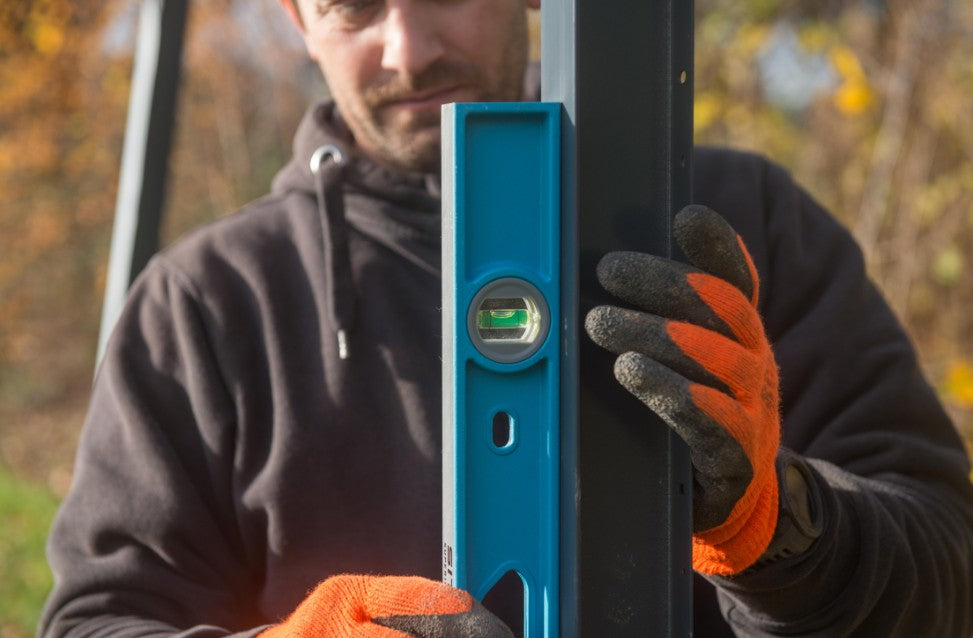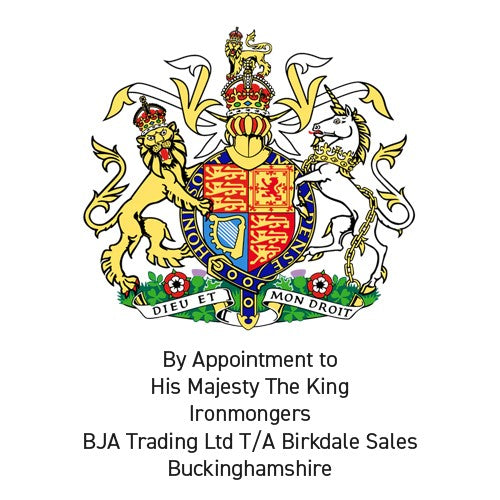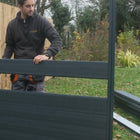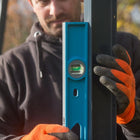Fencing Guide

When it comes to buying or installing a fence there is a whole vernacular of jargon. Some is technical, some is historic, some is fascinating (some is not!). But we thought it was well time that somebody named all the parts and defined them in plain English and that should rightly fall to Birkdale. So here is our A-Z list and our understanding of how the various bits and bobs became so called.

Acoustic fencing
If you live near traffic, you’re going to experience noise. Roads with cars and lorries on are noisy things. In the wet they are even louder. Noise can be more than a nuisance – it can affect your sleep, your health and the value of your property. Putting a barrier between you and the noise can help – and acoustic fencing has been shown in laboratory conditions to reduce noise by up to 32 decibels. That’s the equivalent of bringing the noise of a motor-cycle engine down to the volume of the average conversation.

Arris Rail
As every classical scholar knows the term ‘arris’ comes from the Latin word arista meaning the beard or an ear of grain. What every fence installer knows is that an arris rail is a length of timber with a 45-degree isosceles right angled cross section, which supports a fence between the fence posts. The connection between the name and the timber may well be lost in the midst of time, although we checked and there is no arris rail on Hadrian’s Wall so presumably the Romans have nothing to do with it. However, the arris rail serves another purpose. In general, the side of the fence you find the posts and arris rails determines who erected the fence and therefore owns it – it’s polite to give your neighbour the smart side!
Bay
A bay is the stretch of fence between two posts. We would guess the term comes from the seaside where a bay is the expanse of sand between two headlands. If you know different let us know!
Ballast
Any great seafaring nation such as Britain has a deep-rooted connection with the term ballast – it was the name given to the gravel that ships’ captains would put in the bilges of their ships after unloading their cargo to keep the shop stable. Now if there’s one thing we all know about fences it’s that they need to be stable – and gravel acts as the perfect ballast for a fence post (normally used with some sort of setting medium – see ‘Postcrete’ below).

Build On-site
Most fences are erected on-site using a range of components, although some of those components may be brought to site pre-built (see below). Modern fences, such as the DuraPost® range, which are made from recycled High Density Polyurethane and rice husks are light enough to be easily managed on site and, when it comes to construction, it is increasingly the case of ‘one man and his fence’.
Capping Rail
Once again we’re back with the Romans with the word ‘caput’ or ‘head’ as the derivation of this term. Perhaps more directly in this case ‘cap’ is short for ‘capital’ which in the sense of architecture is the crowning member of a column. In the case of crime of course, it means something for which you can lose your head! Anyway, when it comes to fencing, it’s the rail that goes along the top to make things neat and tidy and pull the whole thing together.

Closeboard
The great Chinese warlord Sun Tzu is credited with the phrase ‘keep your friends close but keep your enemies closer’. If he’d had a closeboard fence he could have had a barbeque with his friends while keeping his enemies out – closeboard fencing is the term used for fencing panels where the individual boards overlap, giving greater degrees of both strength and privacy.
Featheredge / Featherboard
While feathers may be light and fluffy floaty things, ‘feathering’ wood results in a fence board where one edge is thicker than the other, creating a taper effect. This allows individual boards to be overlapped (normally by 40-50mm) to create a closeboard (see above) fence panel that is stronger while keeping a standard thickness throughout a panel that is not at all fluffy nor floaty. Weird that!

Fence Spikes
Depending on what sort of soil you have, fence spikes can be a good, less disruptive and quicker alternative to digging holes and concreting-in your fence posts. The spike element is normally around 50cms long with a square metal ‘box’ on top to secure the fence post. This is banged into the earth (so you need a depth of soil of more than 50cms), then the fence post is inserted.
It’s worth noting that there is a second set of fence spikes, or wall spikes. These are rails of spikes that you can put on top of your fence to deter cats and foxes from jumping over into your garden.
Gate Post
Putting a gate into a fence puts a lot more physical demands upon it – the gate will need to be set on hinges and, when opened, will create torque. This twisting and turning force needs to be absorbed without impacting on the fence as a whole and, therefore, you’re going to need a bigger post. If you need to have a secure gate also bear in mind the non-hinged gatepost which may need to be of equal size in order to be robust enough to carry a decent sized padlock.

Gravel Board
Even Google seems to have no idea how gravel boards got their name – certainly there seems to be no gravel involved. One theory is that during the war, when armies made landings on beaches, they were thrown down to help people and vehicles get a smooth run onto gravel beaches. However, when it comes to fencing, they are quite simply boards that lie along the bottom of a fence in order to protect the fence itself from damp and rot. Traditionally they are made from wood and have, at best, a lifespan of 15 years. In contrast, DuraPost® gravel boards, made from recycled Density Polyurethane and rice husks, are guaranteed for up to 25 years.
Herringbone
In the UK the humble herring has gone out of fashion as a staple food, so most people no longer get to see the rather elegant bone structure of this rather tasty fish. The exception would be those traditionalists who still enjoy a full-on kipper – and what’s not to like about that? In fencing terms ‘herringbone’ panels have boards alternately set at 45º to meet in the middle at 90º to create a ‘zig-zag’ pattern running laterally down the length of the fence. It’s not for everybody, but it’s an interesting design alternative, probably depending on your planting scheme.
Hit-and-Miss
If you live in a windy sort of place, ask yourself this question: ‘do you want a solid fence or one where there are little gaps for the wind to quietly slip through?’ If you answered the latter than a ‘hit-and-miss’ fence might be the answer. Hit-and-miss fences have the individual fencing boards set alternately either side of the upright fence posts. This creates small gaps which wind can work its way through, taking pressure off the fence as a whole. People often ask if hit-and-miss fences are less private – the answer is yes, but practically the amount you can see through a hit-and-miss fence is negligible.
Panel
The basic unit of every garden fence, the panel is the section that runs between fence posts. They come in a variety of shapes and forms, although most are of standard widths and heights. Choose wisely because you’ll be looking at them for many years to come (up to 15 years in the case of DuraPost® panels!).

Pre-built
Many fences are installed on-site from components supplied. Some fence panels however are supplied already built. These are particularly convenient when a fence panel is damaged and needs replacing. Standard pre-fabricated fence panels normally come in 6 foot lengths at a variety of heights of 3, 4, 5 or 6 feet. Yep – fencing hasn’t really gone metric yet, it’s still ‘old school’.
Picket Fencing
A small and delicate thing, picket fences are made up of pointed stakes nailed to an arris rail top and bottom and set between fence posts. But the history of the picket harks back to the 17th century when the French army started ramming pointed stakes, or ‘piquets’ into the earth at an angle to create a defence that cavalry couldn’t cross. In the same way, striking workers create a ‘picket line’. All-in-all it’s a humble thing – normally no more than a metre high, which is the tallest fence you can have in front of a house running along a footpath, without planning permission – but with a long and distinguished provenance.

Post and Rail
Put some posts in the ground, nail rails to them, and bingo – you have a post and rail fence. This is a common sort of fencing you see in the countryside to keep livestock under control often with the posts cut with a rebate into which you can slot an arris rail so no fixing is required.
Post concrete / Postcrete
We talked above about ballast or gravel being a traditional way to keep fence posts upright. But these days concrete, a mixture of cement and ballast, is more common. Amazingly concrete has been around since time immemorial and dates back to around 1300 BCE when builders in the Middle East started applying a coating of lime to their clay walls. Postcrete is a readymade type of concrete that is specially designed to set quickly after water is added – it starts going off after a couple of minutes and is usually set within 5-10 minutes.

Post Supports
Where you can’t easily concrete your fence posts into the earth, other methods of support are required. These may be fence spikes (see above) or supports you bolt onto, say, decking or a hard flooring. There is a wide variety available to suit the individual circumstance. Your fence installer will advise what will work best.
Trellis and Trellis Panels
We’re back in medieval times here with the term ‘trellis’ coming from the Old French word for lattice or grating. Trellis panels may be simply vertical and horizontal in format, or they may be constructed ‘en echelon’ as a forty-five-degree lattice. They are rather lightweight for a robust fence but are often used when climbing plants need to be supported – for example along a garden pathway or at the rear of a border. Or they can be attached as an overlay to an existing fence panel or fence posts using a spacer to permit good plant growth. The great thing about trellis panels is that they can be a feature in their own right or add interesting texture and depth to a boundary. Better still they come in a wide variety of shapes and sizes, allowing for some great creative garden design opportunities.
DuraPost® fencing systems
Create Extraordinary Spaces
DuraPost® steel fence posts and composite fence panels. Find out why they are the ultimate fencing system.






